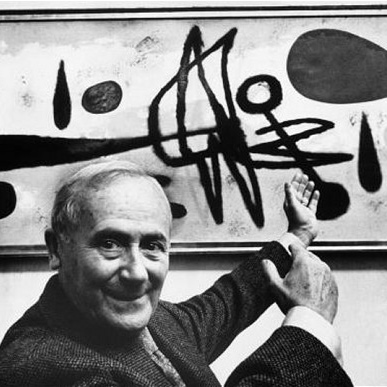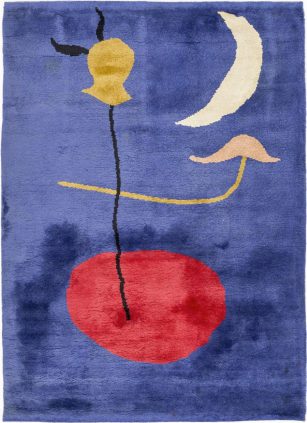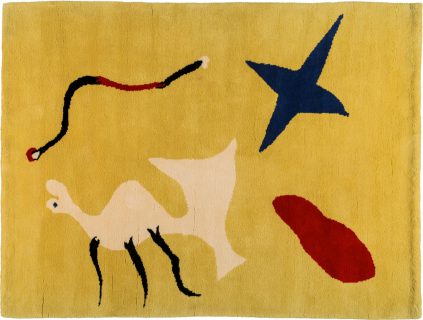Joan Mirò
Artworks
Biography
Joan Miró: The Master of Abstraction and the Art of 20th Century Tapestry
Who is Joan Miró?
Joan Miró (1893-1983) was a renowned Spanish artist, known for his significant contributions to abstract art and surrealism. Born in Barcelona, Miró developed a unique style characterized by organic forms, symbols and vivid colors. His work spans a variety of media, including painting, sculpture, ceramics and tapestry, making him one of the most versatile and influential artists of the 20th century.
The “Woman with a Mirror” Tapestry
“La Femme au Miroir “ is one of Joan Miró‘s most emblematic textile works. This tapestry, created in the workshops of the Manufacture des Gobelins, is part of the prestigious collections of France’s Mobilier National. Miró transposed his unique pictorial language into the medium of tapestry, creating a piece that reflects his distinctive style and innovative approach to art.

©Philippe Servent /Presidence de la Republique
©Philippe Servent /Presidence de la Republique
Image: Tapestry “La Femme au Miroir” by Joan Miró, in the collections of the Mobilier National.
The “Hirondelle” Tapestry
A Work for Nelson Rockefeller and MoMA
The “Hirondelle ” tapestry has a particularly fascinating history. Initially, Nelson Rockefeller, a famous art patron and collector, owned the original painting “Hirondelle ” by Joan Miró. Wishing to donate the painting to the Museum of Modern Art (MoMA ) in New York, Rockefeller commissioned a tapestry to replace the original work in his personal collection.
The Manufacture des Gobelins was commissioned to create the tapestry, ensuring that the essence and visual impact of the original work was preserved in the textile medium. The “Hirondelle ” tapestry has thus become a precious collector’s item, integrating Nelson Rockefeller’s artistic heritage while allowing the original painting to be exhibited at MoMA.

Image: “Hirondelle” tapestry by Joan Miró, in the collections of the Mobilier National.
The Impact of Joan Miró’s Tapestries
The Fusion of Art and Textile
Joan Miró ‘s tapestries represent an innovative fusion of art and textile. Miró transformed his pictorial works into grandiose tapestries, collaborating with craftsmen from the Manufacture des Gobelins and other renowned workshops. His tapestries are not simple reproductions of his paintings, but dynamic reinterpretations that explore the textures and dimensions of textiles.
Miró’s Enduring Legacy in Textile Art
Joan Miró ‘s tapestries continue to have a significant impact on the art world. They are appreciated not only for their beauty and complexity, but also for their ability to translate the essence of Miró’s art into a tactile format. Works such as “La Femme au Miroir ‘ and ’Hirondelle ” illustrate Miró’s genius and ability to push the boundaries of the traditional art form.
Explore Our Collection of Joan Miró Tapestries
We invite you to explore our collection of modern tapestries, including exceptional pieces by Joan Miró. Immerse yourself in the fascinating world of 20th-century art through these unique textile works, and discover how Miró integrated his artistic concepts into the art of tapestry.
Discover how Joan Miró reinvented textile art and explore the impact of his work in our selection of tapestries by 20th-century masters.



